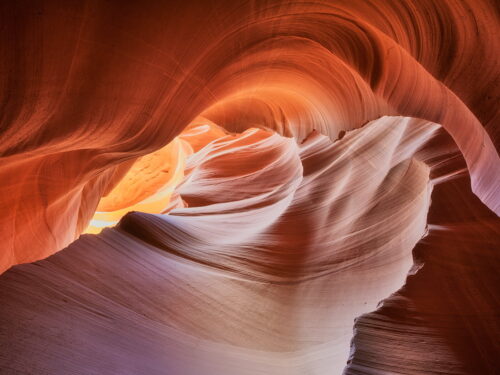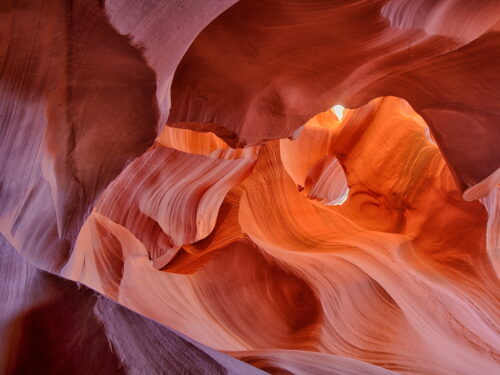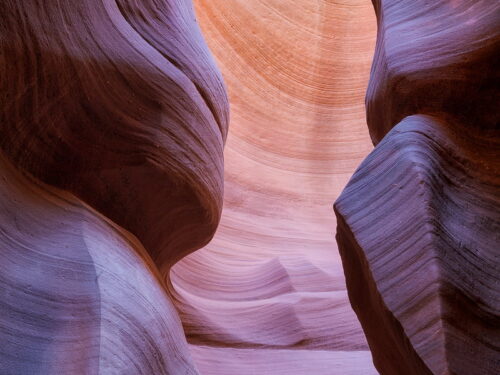L’Antelope Canyon è uno slot canyon (canyon a fessura) formatosi nel corso di milioni di anni per l’azione irruenta dell’acqua che ha eroso l’arenaria e per l’azione modellante dal vento. Si trova nelle vicinanze di Page in Arizona, in territorio Navajo e si snoda in due tronconi : Upper (Superiore) Canyon lungo circa 250 metri e Lower (Inferiore) Canyon lungo 2,5 km, percorribile con maggiori difficoltà vista la sua sinuosità e la strettezza di certi passaggi. E’ stato scoperto da una ragazzina Navajo nel 1931 e deve il suo nome ai branchi di pronghorn (Antilocapra americana) che, un tempo, vagavano liberamente dentro e intorno alla gola.
Semisconosciuto al turismo di massa fino a poco più di una decina di anni fa, è ora una delle mete preferite dei tour del grande West e soprattutto un’icona della fotografia paesaggistica, per tutti i Landscapers del mondo. Qui Peter Link ha realizzato il suo scatto “Phantom”, l’immagine che ha segnato il record del prezzo di vendita di una fotografia: l’autore sostiene di averla venduta nel 2014 ad uno sconosciuto acquirente al prezzo stratosferico di $6,5 milioni.
Durante il tour fotografico con Dreamer Photo Adventures, ho percorso il Lower Antelope Canyon, chiamato Hasdeztwazi in lingua Navajo ( archi di roccia a spirale). Si scende con una serie di scalette per una cinquantina di metri dal piano campagna e ci si ritrova in un altro mondo che avvince e strega per la bellezza delle linee, delle curve, delle forme, dei volumi e dei colori delle rocce che si incuneano nella terra e svettano verso il cielo. Un’esperienza unica, per il gioco di luci e di ombre che si vengono a creare sulle pareti della gola, per l’infiltrazione della luce solare proveniente da strette aperture e che creano sull’arenaria bellissime sfumature di innumerevoli colori, dal rosso all’arancio, dal salmone al viola.
Gli scatti qui sotto riportati sono una selezione delle tante immagini realizzate durante il percorso di quasi tre ore nel Lower Antelope Canyon che, pur non eccellendo in originalità essendo simili ai tantissimi scatti che si possono trovare sul web, per me rappresentano la testimonianza di un’esperienza personale unica, indimenticabile e forse irripetibile.
The Antelope Canyon is a slot canyon formed over millions of years by the impetuous action of water eroding sandstone and by the modeling wind action. This canyon, located near Page (AZ), in the Navajo territory, is divided in two sections: Upper Canyon, with a length of nearly 250 meters and Lower Canyon 2.5 km long, not easily walkable due to its sinuosity and tightness of certain paths. The canyon was discovered by a Navajo girl in 1931 and owes its name to the herds of Pronghorn in the past roamed freely in and around the canyon.
Almost unknown to mass tourism until just over a decade ago, Antelope Canyon is now one of the favorite destinations of the West USA tours and, above all, an icon of landscape photography. In this wonderful location Peter Link made his “Phantom” shot, the image reaching the sale price record for a single photo: the author claims to have sold it in 2014 to an unknown buyer for over $ 6.5 million.
During my photo tour with Dreamer Photo Adventures, I walked through the Lower Antelope Canyon, so-called Hasdeztwazi in Navajo language (spiral rock arches). We went down a series of steps for about fifty meters above ground level jumping in another magic world with beautiful and impressive lines, curves, shapes, volumes and colors of the rocks that wedged in earth and soar into the sky. A massive experience. Light and shadows are created on the walls of the canyon by the sunlight coming in through narrow openings and on the sandstone creating beautiful colourful shades, from red, to orange, from salmon to purple.
The shots shown below are a selection of the many ones taken during my three hours walking in the Lower Antelope Canyon which, while not excelling in originality being similar to the many that can be found on the web, they represent to me the testimony of a personal experience, memorable and perhaps unique.











